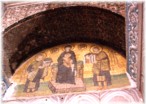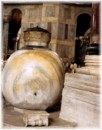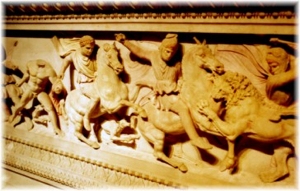Constantinople: Court of the Roman Empire's
Last Pagan Emperor and First Christian Emperor.


Coin Portraits of Julian II and Constantine I
In the photo above left, taken at Constantinople's Hippodrome in modern-day Istanbul, Turkey, is Delphi's Serpent Column in the foreground. This is the very column that bore the Delphi Apollo Temple's Golden Tripod in 479 BCE ! It was looted by Constantine I (The Great). The top right, photo shows the very Walls of Constantinople, finally breached in 1453. These walls stand by the port built by Julian II (the Apostate).


Left : Hagia Sophia, the spiritual and political center of the Roman Empire of the East/ Right : Hagia Sophia's 10th C. Mosaic showing, to the right, Constantine I (Theodosius, to the left).
One of the 7 Wonders of the Ancient World
In Hagia Sophia!



Left : Three of 24 Columns from the Temple of Apollo, Delphi ! / Center : Ancient Bowl from Pergamon. / Right : Two of eight Pillars from the Great Temple of Artemis in Ephesus -- one of the Seven Wonders of the Ancient World ! !.
And the Alexander Sarcophagus
In Constantinople!


In the Archeological Museum of Istanbul stands the fabulous Alexander Sarcophagus ! (4th C. BCE, from the Sidon Necropolis). Left : Full view of the sarcophagus, showing the Battle of Issus. Alexander is in lion head dress to the extreme left. / Right : Close-up of the other side, showing Alexander rescuing a Persian Satrap during a lion hunt.

Lyon, AR Siliqua, 361-363 CE. Obverse: Diademed, draped and cuirassed bust of Julian II right. [RIC VIII 234]

Siscia, Bronze AE3, 307-337 CE. Obverse: Laureate head of Constantine I right, CONSTANTINUS AUGUSTUS. [Sear 3873]
Q: Julian II, nephew of Constantine the Great, was born in Constantinople in about 332 CE, nineteen years after Constantine's "Edict of Milan" granting special priviliges to the Christian Community. [Sear, Roman Coins..., 1988, p.342; Grant, Constantine the Great, 1994, pp.156, 223] What accounts for this chronological inversion of the "Last Pagan Roman Emperor" coming after the "First Christian Emperor?"
A: Julian's paganism was a short-lived reaction to the relatively new but strongly entrenched Christian Religion at court. He had conformed to the Empire's new Chrstian demands but secretly held to the old pagan religion (for which church historians would brand him "Julian the Apostate"). [Sear, Roman Coins..., 1988, p.342] Julian's revival of paganism began in the Balkins with his and his troops openly worshiping the ancient pagan gods when news of Emperor Constantius' death reached him. [Bowersock, Julian the Apostate, 1978, p.79] Julian purged Constantius' court of Christians; however, his pagan revival did not survive his two-year rule: Julian II was a "puritanical pagan" who could not rekindle the old time pagan fervor to the degree necessary to compete with the religion of Constantine I. [Ibid., pp.79-80]